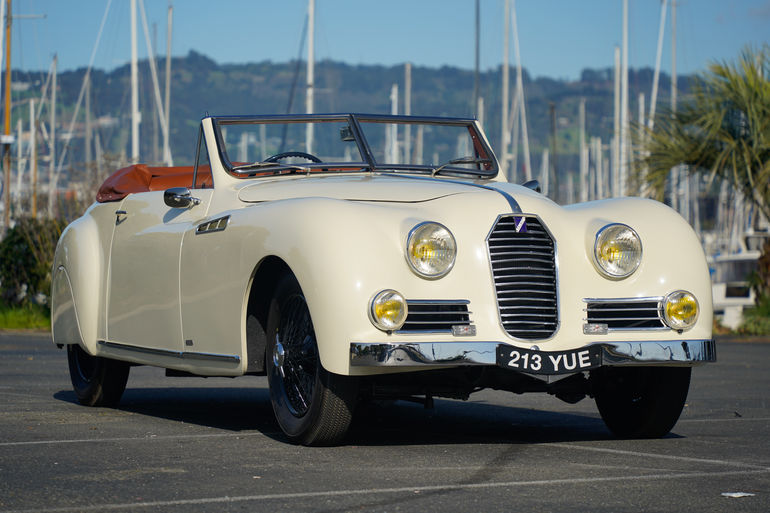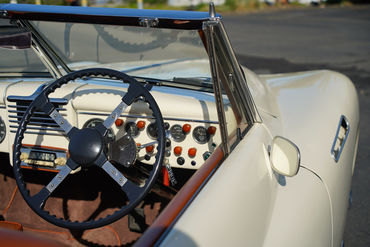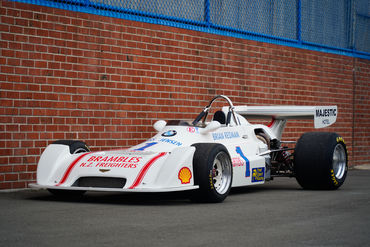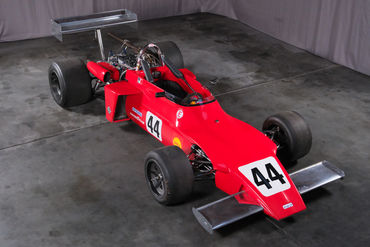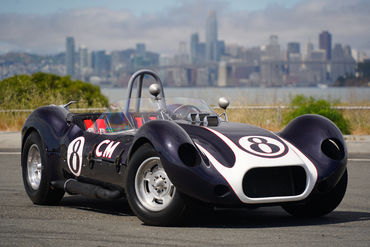Sold
SOLD 11/24
1948 Talbot-Lago
T26 Record Three-Position Cabriolet
Rare and beautiful three-position drophead by Antem of Paris, restored.
- VIN101001
- Exterior ColorCream
- Interior ColorCaramel leather
- Mileage25861 Miles (TMU)
- Engine4482cc inline 6-cylinder
- TransmissionWilson pre-selector 4-Speed
- StatusSold
- StockFJ2853
Description
1948 Talbot-Lago T26 Record Three-Position Cabriolet
Chassis No. – 101001
Coachwork by Carrosserie Antem
Talbot-Lago, one of the great European automotive marques, remains among the most respected and revered manufacturers of the 20th century. Their brilliance in design, engineering, and racing converges on a history of challenge and determination, embodied in the sculptured legacy of their now multimillion-dollar Art Deco era designs. Through wars, financial challenge, and economic uncertainties, nothing deterred Talbot-Lago from perfecting and achieving astonishing automobiles of the finest order. It is this fortitude and demand for perfection that brought so many grand cars to fruition. Such is the case of this magnificently prepared Carrosserie Antem Record T26 Cabriolet.
After the war years, Talbot-Lago emerged with new models designed to take advantage of the new economy associated with post war recovery. Although French currency values challenged their offerings, Talbot-Lago buyers for the new T26 paid up to four times the price of other models, a tribute to the reputation of the Talbot-Lago brand. The Record T26 was offered in four-door and two-door configurations, but also as a two-door cabriolet version which was available with specialized coachwork offered from premium coachbuilders.
This example is one of the most desirable in the Record T26 series. A 4.5L cabriolet fitted with coachwork by Antem. A premier French coachbuilder, Antem had already established a history with Bugatti, Delahaye, and Talbot-Lago so when called upon to provide a suitable showpiece for both Talbot-Lago and Antem, this car was prepared for display at the 1949 Paris Salon where it was greeted by automotive press and wealthy clientele eager to see the latest offering from this Gallic partnership. Offered for the 1950 model year, performance for the new decade featured the 170 hp twin-cam 6-cylinder Lago-Marchetti engine, outfitted with twin Zenith carburetors and mated to the desirable 4-speed manual Wilson pre-select gearbox. This combination made the T26 one of the most powerful cars available at that time. In addition to the power on tap, the all-new chassis featured independent coil-sprung front suspension, large diameter wheels with efficient drum brakes, and favorable weight distribution ideal for the 123” wheelbase.
As documented with ownership records and photos from his extensive archives, premier international historian Nicholas Maier reports after premiering at the 1949 Paris Salon, this T26 was registered under first ownership January 18, 1950. Almost certainly the only one built to these specifications with the Antem coachwork, archived records document more than half a century of continuous European ownership including esteemed collectors in the Netherlands, France, and the United Kingdom. Archived records further include chassis assignment documentation from the factory, January 14, 1950 service guarantee, photos of archived Talbot-Lago record books documenting this car, and photos of the car from various periods including archived photos of the car on display at the 1949 Paris Salon. Under prior ownership, the car was restored in the 1980s and offered at auction in 1987 (archived auction photos on file as well). Ownership records continue through 2006. In 2008 the car was acquired by a collector who found the 1980s restoration to have aged beyond contemporary concours presentation, and thus commissioned a bare metal respray including the welding-in of the front fenders. A novel but challenging detail of Antem coachwork, the pivoting front fenders were a clever feature but resulted in perpetual misalignment and unflattering flow to the otherwise exquisite coachwork. As such, the front fenders were carefully welded in place and lead filled for smooth seams. In addition to the bare metal respray, the exterior was refined, all panels aligned, all trim addressed, and the body finished with classic cream color matching the 1949 Paris Salon debut color. The interior was faithfully reupholstered to a very high standard with rich caramel-hued leather. As a cleverly designed feature, a smartly constructed center console was custom built and finished in matching leather to discreetly house a contemporary sound system with modern amp and tuner.
The restoration was performed using quality materials, historic references, and accurate finishes to properly honor the legacy of these rare and beautiful cars. Among some of the work performed, the dashboard and instruments were refinished, mechanical systems were tended to as needed, a new canvas convertible top and fitted headliner were installed, and fresh carpeting installed in both the cabin and trunk. On the exterior, in addition to the bare metal respray, the trim was removed and freshened, and the unique emblems and sculpted features were refinished. The completed car has since been sorted mechanically and operates quite well, in keeping with the visual beauty of these elegant and powerful cars.
Today this Talbot-Lago presents as an elegant ambassador to the French traditions of the final Art Deco era. The cream finish is glossy, smooth, and the curvaceous body panels exhibit very good fit accented by delicate chrome touches modestly applied in French understated fashion. The exterior of the car is both elegant and sporty with black wire wheels, rear wheel skirts, and a delicate grille conveying the distinctive Talbot-Lago racing lineage. The sculpted front fenders blend seamlessly into the hood and doors, while a two-piece center hinged hood opens at each side to reveal the impressive engine. Given the T26 shares numerous mechanical specifications with the Grand Prix cars of the same period where Chiron placed second at the 1948 Monaco Grand Prix, Chiron again this time winning at the 1950 French Grand Prix, and Rosier winning the 1949 Belgian Grand Prix, there is much more than mere brand behind the performance of this car. The sporty nature of the T26 combines effortlessly into an elegant open car with two positions for the convertible top allowing for open air motoring when covered by the top boot, or cozy rear passenger coverage and front passenger air, perfect for a range of driving conditions. Uncluttered by often garish landau bars and upright formality, even with the top up, the raked windshield, grille, wire wheels and streamlined design conveys the spirit of Talbot-Lago, embracing both spirited motoring and elegant coachwork.
The interior is trimmed in contrasting caramel leather with a matching body colored dashboard. The metal dashboard is adorned with delicate switches, excellent gauges, delicate Art Deco polished trim, and an impressive black steering wheel. The level of detail and execution in the interior is consistent and refined. From the perimeter stitching on the seats and door panels, the discreetly positioned rear panel speakers, center console, and low-profile top boot, all interior features are uniformly composed and elegant. Front seats are roomy, comfortable, and certainly suitable for long distance driving, while the rear seats offer plenty of room for two adult passengers, a feature few vintage touring cars can offer.
Under the centrally hinged hood, the amazing and original 4.5-liter Talbot-Lago engine resides just as it has since it powered this car to the 1949 Paris Salon debut. Finishes here are suitably prepared with mechanical integrity and authenticity in mind. As many experts will attest, many vintage cars are often over-restored with more bright work or highly polished finishes than when originally constructed. The Talbot-Lago engine and components have been properly presented with reverence to originality and intended use. Leaving much of the original character and finishes to speak as part of the history of this car. The undercarriage is clean, unrestored, and properly maintained, reflective of preservation. A recently fitted stainless steel exhaust, heavy duty rear leaf suspension, and correct mechanical fixtures consistent with original production complete the undercarriage presentation.
This Talbot-Lago starts easily and idles smoothly. Gear selection for the 4-speed is easily handled via the column mounted pre-selector. Once underway, driver and passengers are treated to excellent visibility and a comfortable ride. Power is quite good for a large four-passenger vehicle with commendable road manners and braking consistent with the period. A convertible top boot, tonneau cover, and front floor mats accompany the car.
Built for some of the most discerning clientele and offered with rare Antem coachwork, this elegant and sporting Record T26 Cabriolet represents one of the finest Talbot-Lago factory coachbuilt designs of the postwar era. Among the most desirable French sporting automobiles ever built, this documented, coachbuilt 1949 Paris Salon T26 offers a unique ownership experience for those who appreciate elegant open motoring, participation at concours events, and touring at any of the finest vintage automobile gatherings throughout the world.
The above vehicle information is complete and accurate to the best of our knowledge at the time it is posted to this website. Corrections or additional information is always appreciated. All advertised prices exclude government fees and taxes, any finance charges, any dealer document preparation charge, and any emission testing charge. Vehicles are subject to prior sale. All advertised to be true but not guaranteed. We assume no liability for errors or omissions.
Inquire About This Car
Fantasy Junction • 510-653-7555 • 1145 Park Ave, Emeryville, CA 94608
